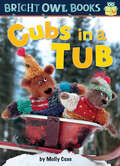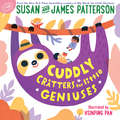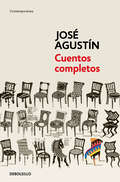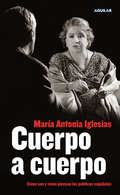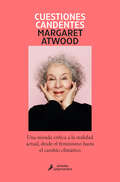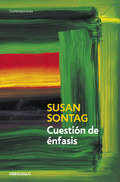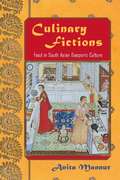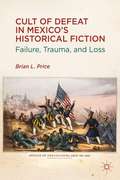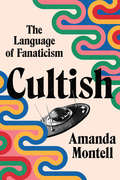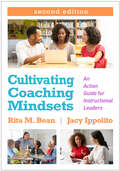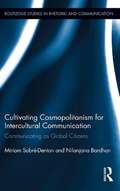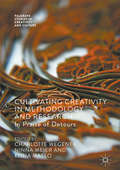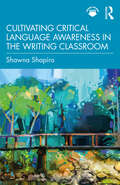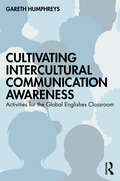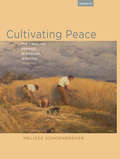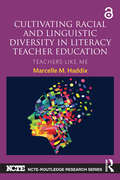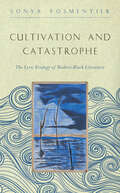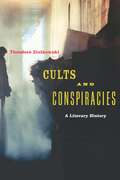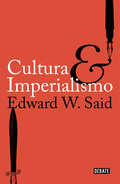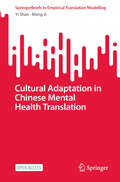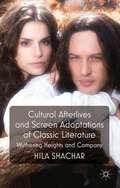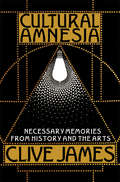- Table View
- List View
Cubs in a Tub (Bright Owl Books)
by Molly CoxeRuss and Gus are bored . . . until they take a tub for a ride. This fun photographic easy-to-read story features the short "u" vowel sound. Kane Press's new series of super simple easy-to-reads, Bright Owl Books, launches with Molly Coxe's five photographic stories, which feature the short vowel sounds and are each only around 100 words. These irresistibly silly stories help kids learn to read through repetition and by teaching the basic building blocks of reading—vowel sounds—giving kids the perfect start on educational success.
Cuddly Critters for Little Geniuses (Big Words for Little Geniuses #2)
by James Patterson Susan Patterson Hsinping PanAxolotes, chinchillas, and sugar gliders--oh my!In this charmingly illustrated follow-up to their first bestselling collaboration, Big Words for Little Geniuses, Susan and James Patterson create a collection of the world's oddest and cutest animals that only little geniuses would know!From sloths to spoonbills and panda ants to pangolins, little geniuses will love learning about all of the unusual, adorable animals that live on this planet. More than 50 little-known flyers, swimmers, and crawlers are included in this book, whimsically illustrated by artist Hsinping Pan. Cuddly Critters for Little Geniuses will remind you that nature contains many wonders--and these cute and curious creatures are no exception!
Cuentos
by Charles PerraultUn gato que se las trae; Pulgarcito, un niño tan pequeño como valeroso; una Caperucita Roja que se deja engañar ingenuamente; la hermosa Cenicienta y sus envidiosas hermanastras... son los principales personajes cuyas aventuras y desventuras se narran en estos cuentos inmortales.
Cuentos completos
by José AgustínTodos los cuentos de José Agustín, el autor más emblemático de La Onda y uno de los mejores narradores en México. Esta antología reúne todas las narraciones cortas que José Agustín publicara entre 1968 y 2002: desde Inventando que sueño (1968), No hay censura (1988) y No pases esta puerta (1992), hasta los relatos de Los grandes discos de rock (2001) y el extenso relato inédito Los ojos de los demás (2002). Ésta es, en pocas palabras, la recopilación que los lectores de José Agustín esperábamos con tanto anhelo. Los relatos que aparecen en Cuentos completos destacan, como el resto de la obra de José Agustín, por su originalidad, por la fusión de la tradición con la rebeldía, por el humor, la irreverencia y por el profundo y sutil erotismo que habita estas historias. Cuentos completos incluye textos clásicos como Cuál es la onda, Amor del bueno y Transportarán a un cadáver por exprés, relatos que abrieron nuevos caminos para la narrativa mexicana y que representan una de las propuestas literarias más ambiciosas en la historia de nuestras letras.
Cuerpo a cuerpo: Cómo son y cómo piensan los políticos españoles
by María Antonia IglesiasCuerpo a cuerpo no es solo un libro de entrevistas a políticos de todos los partidos, de todas las ideas. Es el resultado de una apasionante aventura: la de aproximarse a los personajes sin máscaras. Para preguntar, para escuchar, para comprender. María Antonia Iglesias no es solo una gran entrevistadora, es una mujer que, desde su papel de periodista, intenta descubrir la realidad saltando por encima de los prejuicios y de los lugares comunes. En Cuerpo a cuerpo se reúnen sus mejores entrevistas, en su mayoría políticas, un subgénero condenado por su propia naturaleza a responder al día a día. Sin embargo, las de María Antonia Iglesias superan los márgenes de la actualidad para convertirse en el retrato de un personaje y de un momento de nuestra historia reciente. Quizá eso sucede porque aplica de forma generosa y constante una misma metodología, la que ella misma nos cuenta en la introducción de su libro: «Escuchar para aprender, para comprender. Éste ha sido el sentido último de las entrevistas que he publicado en El País en los últimos diez años y de las que he seleccionado para este libro las cien que mejor resumen el reto de enfrentar al personaje consigo mismo. Lograr que los entrevistados (políticos en su gran mayoría, que se blindan tanto) digan en alta voz aquello que piensan, pero que no tenían intención de decir, persuadirlos para que abandonen la posición defensiva y disfruten, incluso, con la verdad de sus reflexiones más recónditas. Ése era siempre mi objetivo en ese cuerpo a cuerpo a veces duro, estimulante siempre, en el que siempre también he buscado la verdadera inteligencia con el otro.»María Antonia Iglesias
Cuestiones candentes: Una mirada crítica a la realidad actual, desde el feminismo hasta el cambio climático
by Margaret AtwoodUna brillante colección de ensayos que abarca desde la deuda pública hasta la naturaleza de la ciencia ficción y la crisis climática. La galardonada y exitosa autora de El cuento de la criada y Los testamentos ofrece su divertida, erudita, curiosa y asombrosamente clarividente visión del mundo, desde la deuda y la tecnología hasta la crisis climática y la libertad, y busca respuestas a cuestiones candentes como... ¿Por qué la gente cuenta historias, sea cual sea su cultura? ¿Cuánto puedes dar de ti sin evaporarte? ¿Cómo podemos vivir en nuestro planeta? ¿Qué relación hay entre los zombis y el autoritarismo? Una colección de ensayos de actualidad con el marchamo indiscutible de la que quizá sea la novelista viva más famosa y, sin duda, la más venerable de nuestro tiempo. Reseñas:«Ésta no es una mera colección de ensayos para los entusiastas de Atwood. Más bien es un intento de dar sentido al mundo, que aborda con un brío característico cualquier cosa, desde Ana la de Tejas Verdes a Donald Trump, desde los zombis a la censura [...]. Mientras que el tono se mueve entre el ingenio surrealista fuera de serie y la gravedad desapasionada, Atwood siempre consigue que la idea de las grandes preguntassea un poco más digerible. [...] La colección es polifónica, entusiasta, esclarecedora.»Sophie Macintosh, i News «Es fascinante leer las reflexiones de Atwood sobre sus propias novelas [...], pero también es llamativo ver cuántas piezas incluye en este libro que celebran de manera generosa a otros escritores.»Stephanie Merritt, The Observer«Si hay una persona en el mundo cuya opinión sobre las cuestiones más apremiantes te gustaría conocer, seguramente sería Margaret Atwood. [...] Da respuesta a preguntas candentes sobre el cambio climático, el ascenso de Trump y sobre la deuda técnica.»Joanna Taylor, Evening Standard«Una colección de ensayos para devanarse los sesos de Margaret Atwood, la autora ganadora del premio Booker. Percepciones maravillosamente escritas que van desde los zombis a la crisis climática.»Stylist «Me bebí el libro el fin de semana pasado, de dos cálidos tragos.»Jennifer Senior, The Atlantic
Cuestión de énfasis
by Susan SontagUn brillante libro de ensayos de Susan Sontag, sobre literatura, cine, fotografía, pintura, artes escénicas y sobre la figura del intelectual. Treinta y cinco años después de su primera colección de ensayos, el hoy clásico Contra la interpretación, Susan Sontag seleccionó cuarenta y un textos compuestos entre 1982 y 2003 y los dividió en las tres secciones de este libro. «Lecturas» recoge apasionados ensayos sobre escritores de su canon personal, como Barthes, Sebald, Borges, Tsvetáieva y Rulfo. En «Miradas» comparte su pasión por el cine, la fotografía, la pintura y las artes escénicas. Finalmente, en «Allí y aquí», indaga en su compromiso (y su activismo) por la construcción de una conciencia y en su vocación de escritora. Reseña:«Un documento para verificar el paso del tiempo en el cuerpo de una generación que se forjó en esa moneda de cara y cruz que fueron Nueva York y París en los años dorados.»Mauro Libertella, Página/12
Culinary Fictions: Food in South Asian Diasporic Culture
by Anita MannurFor South Asians, food regularly plays a role in how issues of race, class, gender, ethnicity, and national identity are imagined as well as how notions of belonging are affirmed or resisted. Culinary Fictions provides food for thought as it considers the metaphors literature, film, and TV shows use to describe Indians abroad. When an immigrant mother in Jhumpa Lahiri’s The Namesake combines Rice Krispies, Planters peanuts, onions, salt, lemon juice, and green chili peppers to create a dish similar to one found on Calcutta sidewalks, it evokes not only the character’s Americanization, but also her nostalgia for India. Food, Anita Mannur writes, is a central part of the cultural imagination of diasporic populations, and Culinary Fictions maps how it figures in various expressive forms. Mannur examines the cultural production from the Anglo-American reaches of the South Asian diaspora. Using texts from novels-Chitra Divakaruni’s Mistress of Spices and Shani Mootoo’s Cereus Blooms at Night-and cookbooks such as Madhur Jaffrey’s Invitation to Indian Cooking and Padma Lakshmi’s Easy Exotic, she illustrates how national identities are consolidated in culinary terms.
Cult of Defeat in Mexico’s Historical Fiction
by Brian L. PriceCult of Defeat in Mexico's Historical Fiction: Failure, Trauma, and Loss examines recent Mexican historical novels that highlight the mistakes of the nineteenth century for the purpose of responding to present crises.
Cultish: The Language of Fanaticism
by Amanda Montell“One of those life-changing reads that makes you see—or, in this case, hear—the whole world differently.” —Megan Angelo, author of Followers“At times chilling, often funny, and always perceptive and cogent, Cultish is a bracing reminder that the scariest thing about cults is that you don't realize you're in one till it's too late.”—Refinery29.comThe New York Times bestselling author of The Age of Magical Overthinking and Wordslut analyzes the social science of cult influence: how “cultish” groups, from Jonestown and Scientologists to SoulCycle and social media gurus, use language as the ultimate form of power.What makes “cults” so intriguing and frightening? What makes them powerful? The reason why so many of us binge Manson documentaries by the dozen and fall down rabbit holes researching suburban moms gone QAnon is because we’re looking for a satisfying explanation for what causes people to join—and more importantly, stay in—extreme groups. We secretly want to know: could it happen to me? Amanda Montell’s argument is that, on some level, it already has . . .Our culture tends to provide pretty flimsy answers to questions of cult influence, mostly having to do with vague talk of “brainwashing.” But the true answer has nothing to do with freaky mind-control wizardry or Kool-Aid. In Cultish, Montell argues that the key to manufacturing intense ideology, community, and us/them attitudes all comes down to language. In both positive ways and shadowy ones, cultish language is something we hear—and are influenced by—every single day. Through juicy storytelling and cutting original research, Montell exposes the verbal elements that make a wide spectrum of communities “cultish,” revealing how they affect followers of groups as notorious as Heaven’s Gate, but also how they pervade our modern start-ups, Peloton leaderboards, and Instagram feeds. Incisive and darkly funny, this enrapturing take on the curious social science of power and belief will make you hear the fanatical language of “cultish” everywhere.
Cultivating Coaching Mindsets: An Action Guide for Instructional Leaders
by Rita M. Bean Jacy IppolitoNow in a revised and updated second edition for today's changing K–12 landscape, this book gives instructional coaches an innovative framework for building strong relationships and enacting positive change in schools. Emphasizing a systems approach, Rita M. Bean and Jacy Ippolito explain the multiple roles of the coach as change agent, facilitator, designer, and advocate. Vivid examples show how effective coaches draw on these mindsets in working with individual teachers and groups and in developing, implementing, and sustaining schoolwide instructional programs. The book is rich with &“Voices from the Field&” vignettes; chapter-opening questions; and end-of-chapter discussion prompts, learning activities, and resources. Reproducible coaching tools can be copied from the book or downloaded from the companion website. New to This Edition *Broader scope--addresses coaching across all instructional areas, not just literacy. *Discussions of virtual instruction and coaching, the coach's role in supporting equity, and other timely topics. *Significantly revised case study chapter, with three new cases. *Incorporates current research, lessons learned in the field, and the ongoing development of the mindsets model.
Cultivating Cosmopolitanism for Intercultural Communication: Communicating as a Global Citizen (Routledge Studies in Rhetoric and Communication #15)
by Miriam Sobre-Denton Nilanjana BardhanWinner of the National Communication Association's International and Intercultural Communication Division's 2014 Outstanding Authored Book of the Year award This book engages the notion of cosmopolitanism as it applies to intercultural communication, which itself is undergoing a turn in its focus from post-positivistic research towards critical/interpretive and postcolonial perspectives, particularly as globalization informs more of the current and future research in the area. It emphasizes the postcolonial perspective in order to raise critical consciousness about the complexities of intercultural communication in a globalizing world, situating cosmopolitanism—the notion of global citizenship—as a multilayered lens for research. Cosmopolitanism as a theoretical repertoire provides nuanced descriptions of what it means to be and communicate as a global citizen, how to critically study interconnectedness within and across cultures, and how to embrace differences without glossing over them. Moving intercultural communication studies towards the global in complex and nuanced ways, this book highlights crucial links between globalization, transnationalism, postcolonialism, cosmopolitanism, social injustice and intercultural communication, and will help in the creation of classroom spaces devoted to exploring these links. It also engages the links between theory and praxis in order to move towards intercultural communication pedagogy and research that simultaneously celebrates and interrogates issues of cultural difference with the aim of creating continuity rather than chasms. In sum, this book orients intercultural communication scholarship firmly towards the critical and postcolonial, while still allowing the incorporation of traditional intercultural communication concepts, thereby preparing students, scholars, educators and interculturalists to communicate ethically in a world that is simultaneously global and local.
Cultivating Creativity in Methodology and Research: In Praise of Detours (Palgrave Studies in Creativity and Culture)
by Charlotte Wegener Ninna Meier Elina MasloThis book presents a variety of narratives on key elements of academic work, from data analysis, writing practices and engagement with the field. The authors discuss how elements of academic work and life - usually edited out of traditional research papers - can elicit important analytical insight. The book reveals how the unplanned, accidental and even obstructive events that often occur in research life, the 'detours', can potentially glean important results. The authors introduce the process of 'writing-sharing-reading-writing' as a way to expand the playground of research and inspire a culture in which 'accountable' research methodologies involve adventurousness and an element of uncertainty. Written by scholars from a range of different fields, academic levels and geographic locations, this unique book will offer significant insight to those from a range of academic fields.
Cultivating Critical Language Awareness in the Writing Classroom
by Shawna ShapiroThis book introduces Critical Language Awareness (CLA) Pedagogy as a robust and research-grounded framework to engage and support students in critical examinations of language, identity, privilege and power.Starting with an accessible introduction to CLA, chapters cover key topics—including World Englishes, linguistic prejudice, news media literacy, inclusive language practices, and more—in an inviting and thought-provoking way to promote reflection and analysis. Part I provides an overview of the foundations of CLA pedagogy, while Part II highlights four instructional pathways for CLA pedagogy: Sociolinguistics, Critical Academic Literacies, Media/Discourse Analysis, and Communicating Across Difference. Each pathways chapter is structured around Essential Questions and Transferrable Skills, and includes three thematic learning sequences. Part III offers tools and guidance for tailoring CLA pedagogy to the reader’s own teaching context and to students’ individual needs. The volume’s wealth of resources and activities are a pedagogical toolkit for supporting and embracing linguistic diversity in the classroom. The cohesive framework, concrete strategies, engaging activities, and guiding questions in this volume allow readers to come away with not only a deeper understanding of CLA, but also a clear roadmap for implementing CLA pedagogy in the classroom. Synthesizing relevant research from educational linguistics and writing studies, this book is ideal for courses in English/literacy education, college composition, L2 writing instruction, and educational linguistics.
Cultivating Intercultural Communication Awareness: Activities for the Global Englishes Classroom
by Gareth HumphreysIn an increasingly interconnected world, supporting students as they learn to communicate in linguistically diverse intercultural settings is a significant aim of English language and international education. To address this educational objective, this book breaks down the complexities associated with global English in intercultural communication and it challenges conventional educational focuses through activities that promote intercultural awareness and citizenship.The resource book offers pre-service teachers and educators a range of activities grounded in contemporary perspectives on Global Englishes, intercultural learning, and intercultural citizenship education. The book shifts the focus from teaching to imitate native-like proficiency by providing educators with practices and ideas to develop students who are globally aware, can handle complexities of communicating using English as a lingua franca (ELF), and can act as responsible intercultural citizens in a globalised society. Around 120 practical activities are presented for use in supplementing existing curricula or in the design of new learning programmes.This book is a key resource for pre-service teachers and educators involved in English language education, international education, and intercultural education, as well as for scholars and instructors of applied linguistics, TESOL preparation programmes, and teacher education programmes.
Cultivating Peace: The Virgilian Georgic in English, 1650-1750 (Transits: Literature, Thought & Culture 1650-1850)
by Melissa SchoenbergerDuring the decades following the English civil wars, British poets seeking to make sense of lingering political instabilities turned to Virgil’s Georgics. This ancient poem betrays deep ambivalences about war, political power, and empire, and such poets as Andrew Marvell, John Dryden, and Anne Finch found in these attitudes valuable ways of responding to the uncertainties of their own time. Composed during a period of brutal conflict in Rome, Virgil’s agricultural poem distrusts easy stability, urging its readers to understand that lasting peace must be sowed, tended, reaped, and replanted, year after year. Like the ancient poet, who famously depicted a farmer’s scythe suddenly recast as a sword, the poets discussed in Cultivating Peace imagine states of peace and war to be fundamentally and materially linked. In distinct ways, they dismantle the dream of the golden age renewed, proposing instead that peace must be sustained by constant labor. Published by Bucknell University Press. Distributed worldwide by Rutgers University Press.
Cultivating Racial and Linguistic Diversity in Literacy Teacher Education: Teachers Like Me (NCTE-Routledge Research Series)
by Marcelle M. HaddixCultivating Racial and Linguistic Diversity in Literacy Teacher Education examines how English and literacy teacher education—a space dominated by White, English-monolingual, middle class perspectives—shapes the experiences of preservice teachers of color and their construction of a teacher identity. Significant and timely, this book focuses attention on the unique needs and perspectives of racially and linguistically diverse preservice teachers in the field of literacy and English education and offers ways to improve teacher training to better meet the needs of preservice teachers from all racial, ethnic, and linguistic backgrounds. These changes have the potential to diversify the teacher force and cultivate teachers who bring rich racial, cultural, and linguistic histories to the field of teaching.
Cultivating Racial and Linguistic Diversity in Literacy Teacher Education: Teachers Like Me (NCTE-Routledge Research Series)
by Marcelle M. HaddixCultivating Racial and Linguistic Diversity in Literacy Teacher Education examines how English and literacy teacher education—a space dominated by White, English-monolingual, middle class perspectives—shapes the experiences of preservice teachers of color and their construction of a teacher identity.Significant and timely, this book focuses attention on the unique needs and perspectives of racially and linguistically diverse preservice teachers in the field of literacy and English education and offers ways to improve teacher training to better meet the needs of preservice teachers from all racial, ethnic, and linguistic backgrounds. These changes have the potential to diversify the teacher force and cultivate teachers who bring rich racial, cultural, and linguistic histories to the field of teaching.Chapters 1, 2, and 3 of this book are freely available as downloadable Open Access PDFs at http://www.taylorfrancis.com under a Creative Commons Attribution-Non Commercial-No Derivatives (CC-BY-NC-ND) 4.0 license.
Cultivation and Catastrophe: The Lyric Ecology of Modern Black Literature (The <I>Callaloo</I> African Diaspora Series)
by Sonya PosmentierA transformative literary history of black environmental writing.Winner, William Sanders Scarborough Prize by the Modern Language AssociationAt the intersection of social and environmental history there has emerged a rich body of Black literary response to natural and agricultural experiences, whether the legacy of enforced agricultural labor or the destruction and displacement brought about by a hurricane. In Cultivation and Catastrophe, Sonya Posmentier uncovers a vivid diasporic tradition of Black environmental writing that responds to the aftermath of plantation slavery, urbanization, and free and forced migrations. While humanist discourses of African American and postcolonial studies often sustain a line between nature and culture, this book instead emphasizes the relationship between them, offering an innovative environmental history of modern black literature.
Cults and Conspiracies: A Literary History
by Theodore ZiolkowskiExplore 2,000 years of conspiracy in literature.Outstanding Academic Title, ChoiceHuman beings have believed in conspiracies presumably as long as there have been groups of at least three people in which one was convinced that the other two were plotting against him or her. In that sense one might look back as far as Eve and the serpent to find the world’s first conspiracy. Whereas recent generations have tended to find their conspiracies in politics and government, the past often sought its mysteries in religious cults or associations. In ancient Rome, for example, the senate tried to prohibit the cult of Isis lest its euphoric excesses undermine public morality and political stability. And during the Middle Ages, many rulers feared such powerful and mysterious religious orders as the Knights Templar.Fascination with the arcane is a driving force in this comprehensive survey of conspiracy fiction. Theodore Ziolkowski traces the evolution of cults, orders, lodges, secret societies, and conspiracies through various literary manifestations—drama, romance, epic, novel, opera—down to the thrillers of the twenty-first century. Arguing that the lure of the arcane throughout the ages has remained a constant factor of human fascination, Ziolkowski demonstrates that the content of conspiracy has shifted from religion by way of philosophy and social theory to politics. In the process, he reveals, the underlying mythic pattern was gradually co-opted for the subversive ends of conspiracy.Cults and Conspiracies considers Euripides’s Bacchae, Andreae’s Chymical Wedding, Mozart’s The Magic Flute, and Eco’s Foucault’s Pendulum, among other seminal works. Mimicking the genre’s quest-driven narrative arc, the reader searches for the significance of conspiracy fiction and is rewarded with the author’s cogent reflections in the final chapter. After much investigation, Ziolkowski reinforces Umberto Eco’s notion that the most powerful secret, the magnetic center of conspiracy fiction, is in fact "a secret without content."
Cults and Rites in Ancient Greece
by Paul Cartledge Michael H. Jameson Allaire B. Stallsmith Michael H. Jameson Allaire B. StallsmithThis volume assembles fourteen highly influential articles written by Michael H. Jameson over a period of nearly fifty years, edited and updated by the author himself. They represent both the scope and the signature style of Jameson's engagement with the subject of ancient Greek religion. The collection complements the original publications in two ways: firstly, it makes the articles more accessible; and secondly, the volume offers readers a unique opportunity to observe that over almost five decades of scholarship Jameson developed a distinctive method, a signature style, a particular perspective, a way of looking that could perhaps be fittingly called a 'Jamesonian approach' to the study of Greek religion. This approach, recognizable in each article individually, becomes unmistakable through the concentration of papers collected here. The particulars of the Jamesonian approach are insightfully discussed in the five introductory essays written for this volume by leading world authorities on polis religion.
Cultura e imperialismo (Colección Argumentos/anagrama Ser. #Vol. 187)
by Edward W. SaidPublicada originalmente en 1993, Cultura e imperialismo es una obra indispensable que restablece el diálogo entre la literatura y la vida, y permite comprender uno de los procesos históricos y culturales más complejos de la modernidad. En el siglo XIX y principios del XX, mientras las grandes potencias se esforzaban en construir y mantener imperios que se extendían desde Australia hasta las islas del Caribe, Occidente fue el protagonista incontestable de un esplendor cultural que vio nacer obras maestras tales como la Aida de Verdi, Mansfield Park de Jane Austen, El corazón de las tinieblas de Conrad o El extranjero de Camus, por citar solo algunas. Con todo, y a pesar de la magnitud del fenómeno imperialista que caracterizó esa época, la mayoría de críticos literarios y culturales nunca prestaron la suficiente atención a su influencia sobre la cultura. Mediante un brillante análisis, Edward W. Said examina estas obras junto con la de escritores de la talla de W. B. Yeats, Chinua Achebe o Salman Rushdie, para demostrar como la periferia sujeta al orden impuesto por la metrópoli supo crear su propia cultura vigorosa, opositora y resistente. Críticas:«Obra imprescindible.»José María Ridao, El País «La originalidad y la eficacia de este estudio se basan en el método. Said trabaja sobre las obras individuales, leyéndolas primero como grandiosos productos de la imaginación creadora e interpretativa, y luego mostrándolas dentro de la relación entre cultura e imperio.»Elvira Huelbes, El Mundo «Pivote entre dos mundos, solo Said ha sido capaz de advertir que la apacible rutina de Mansfield Park, la mansión en la novela de Jane Austen, se mantiene con el trabajo esclavo de una isla del Caribe. Sin imperio, proclama Said, no existiría la novela clásica europea tal como la conocemos.»Terry Eagleton, The Guardian «La crítica literaria que intenta tender puentes entre el arte y la política tiene que aprender mucho, si no todo, de este impresionante diálogo de Said consigo mismo.»Camille Paglia, The Washington Post
Cultural Adaptation in Chinese Mental Health Translation (New Frontiers in Translation Studies)
by Meng Ji Yi ShanThis open access book demonstrates the necessity, feasibility, and effectiveness of cultural adaptation in the translation of mental health scales into Chinese. It illustrates the key principles of culturally effective mental health translation, through offering in-depth discussions of the methods and techniques used to translate mental health materials into Chinese. This SpringerBrief title provides an essential reading for academics, researchers, students from language studies, public health and health communication who are interested to develop more advanced skills of translating and adapting mental health instruments for people from culturally and linguistically diverse backgrounds.
Cultural Afterlives and Screen Adaptations of Classic Literature
by Hila ShacharFilm and television adaptations of classic literature have held a longstanding appeal for audiences, an appeal that this book sets out to examine. With a particular focus on Wuthering Heights , the book examines adaptations made from the 1930s to the twenty-first century, providing an understanding of how they help shape our cultural landscape.
Cultural Amnesia: Necessary Memories From History And The Arts
by Clive James"I can't remember when I've learned as much from something I've read—or laughed as much while doing it." —Jacob Weisberg, Slate This international bestseller is an encyclopedic A-Z masterpiece—the perfect introduction to the very core of Western humanism. Clive James rescues, or occasionally destroys, the careers of many of the greatest thinkers, humanists, musicians, artists, and philosophers of the twentieth century. Soaring to Montaigne-like heights, Cultural Amnesia is precisely the book to burnish these memories of a Western civilization that James fears is nearly lost.
